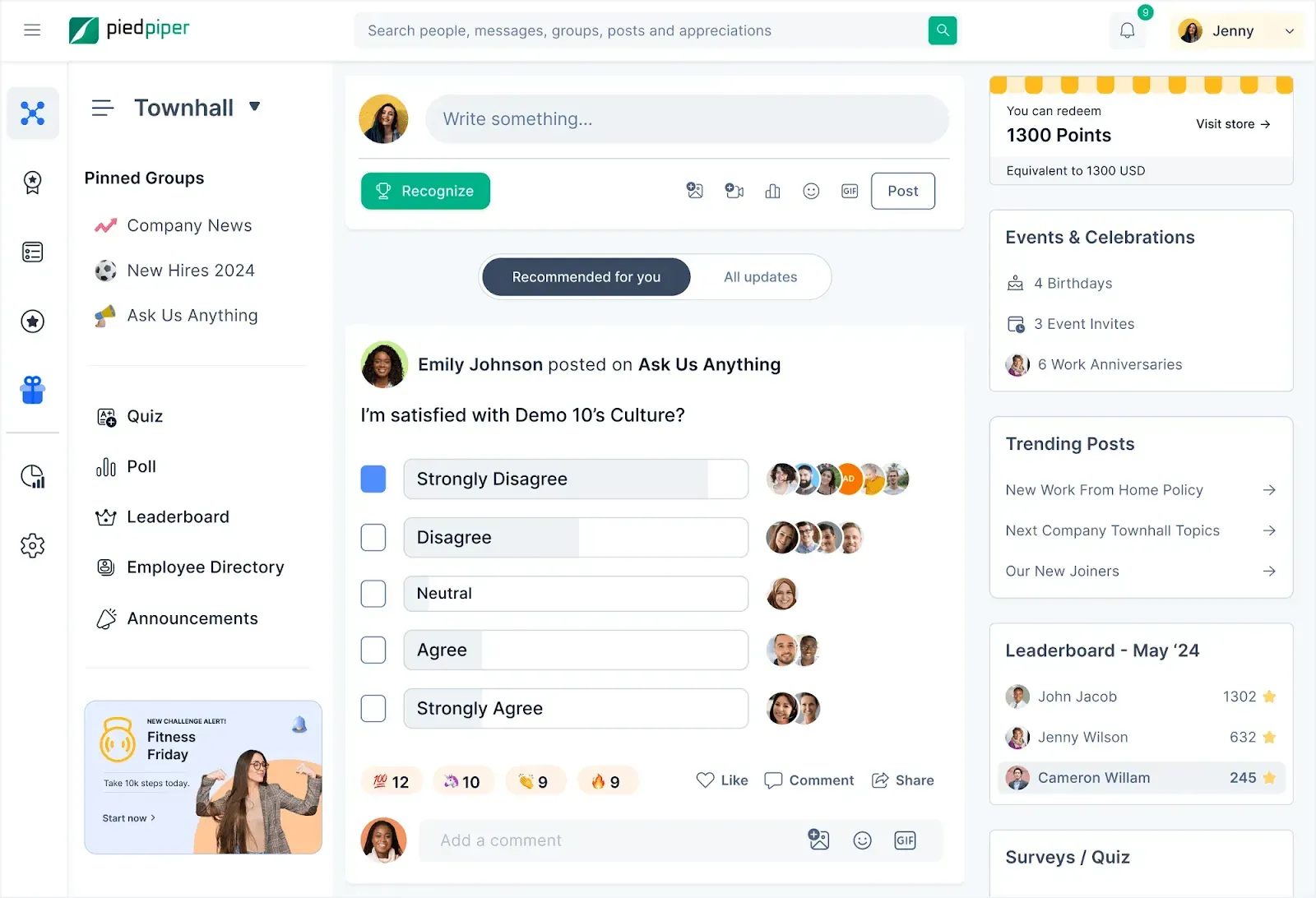How to Improve Employee Morale and Increase Productivity: Strategies for a Motivated, Engaged
Low morale hurts productivity and workplace culture. Boost employee morale with recognition, communication, and growth opportunities. Valued employees perform better and stay committed, driving business success. Use these strategies to build a motivated team.
En esta página
- How does morale affect productivity?
- Signs of low employee morale
- ¿Cómo se puede mejorar la moral de los empleados en el lugar de trabajo?
- Examples of companies boosting employee morale
- How Empuls supercharges employee morale and productivity
- Conclusion: Sustaining morale for long-term productivity
- Preguntas frecuentes
La moral.
It’s the energy that fuels motivation, the difference between an engaged employee and one who’s simply clocking in and out. It’s what makes employees bring their best to work instead of dragging their feet through the day.
Forbes defines employee morale as “...the job satisfaction, attitude, and outlook that employees have while at your business.” A workplace thrives when morale is high, and productivity follows. But when motivation dips, so does performance, collaboration, and overall workplace culture.
Businesses depend on their employees to grow, innovate, and succeed. When morale drops, burnout creeps in, 😫😞 and productivity takes a hit. A Gallup study found that 23% of employees experience burnout at work very often or always, while another 44% report feeling burned out sometimes. That’s nearly two-thirds of the workforce struggling to stay motivated.
Boosting employee morale isn’t optional—it’s a necessity. A team that feels valued, recognized, and supported works harder, stays longer, and drives business success.
How does morale affect productivity?
There’s a direct link between employee morale and productivity. When morale is high, employees are motivated, committed, and far more likely to put in their best effort.
Gallup study found that highly engaged teams show 21% greater profitability, emphasizing the impact of morale on a company’s success. Conversely, low morale can have a ripple effect, dragging down productivity as employees become disengaged, less enthusiastic, and even more prone to errors.
When employees feel unappreciated or overwhelmed, their performance naturally declines, resulting in missed deadlines, lower quality of work, and a lack of initiative. Keeping morale high ensures a workplace where employees are eager to contribute and go above and beyond.
Signs of low employee morale
Recognizing the signs of low employee morale is crucial for addressing issues before they escalate. Here are some common indicators:
1. Increased absenteeism
When employees start taking more sick days or frequently call in absent, it’s often a red flag. While personal reasons may play a role, increased absenteeism can also signal disengagement or burnout. Employees with low morale may feel less motivated to show up for work, especially if they no longer feel invested in their roles.
2. Decline in productivity
A drop in the quality or quantity of work is another clear sign of low morale. Employees may struggle to focus, miss deadlines, or deliver subpar work because they’ve lost their motivation and drive. When employees are disengaged, they often put in less effort, leading to lower overall team productivity and increased errors.
3. Lack of communication
Employees who were once active in discussions or proactive in sharing ideas may become silent when morale is low. They may avoid meetings, not contribute in team discussions, or seem reluctant to voice their thoughts. This withdrawal from communication indicates they feel disconnected or undervalued.
4. Negative attitude
Low morale can lead to a noticeable shift in an employee’s attitude. This may manifest as increased complaints about work, tension among coworkers, or a general pessimistic outlook. The once-positive energy of the team can turn toxic, affecting both individual performance and the overall work environment.
5. Tasas de rotación elevadas
When employees leave the company more frequently, it’s often because they’re seeking a better work environment. High turnover is a major sign that employee morale has deteriorated, as employees no longer see a future with the company or feel appreciated. This can also result in a loss of talent and higher costs related to recruiting and training new staff.
Identifying these signs early on allows managers to address morale issues before they spiral out of control, improving both retention and team dynamics.
¿Cómo se puede mejorar la moral de los empleados en el lugar de trabajo?
Si quiere evitarlo, aquí tiene algunos consejos para elevar la moral de los empleados en el lugar de trabajo, restaurar el entusiasmo y el compromiso entre su plantilla de forma rápida y eficaz.
1. Meaningful work and autonomy
Cuando los empleados sienten que su trabajo tiene sentido y está en consonancia con los valores y objetivos de la empresa, su moral mejora. Además, dar a los empleados cierto grado de autonomía en sus funciones y en la toma de decisiones puede aumentar su sentido de pertenencia y su satisfacción laboral.
This led to what Buffer called empowered accountability.
“We want to ensure that team members lean into their expertise when making decisions and providing support,” Åsa Nyström, VP of Customer Advocacy, explains. “We want to remove hesitation about decision-making and to enable our team to support our customers the best we can.”
2. Provide care packages to remote workers
Las circunstancias actuales a las que se enfrentan muchas empresas en todo el mundo, con el trabajo a distancia que se hace inevitable al dejar de funcionar los espacios de oficina compartidos, significa que se está produciendo un nuevo tipo de agotamiento de los empleados.
Una encuesta de Glint realizada a más de 700.000 empleados de todo el mundo descubrió que los comentarios relacionados con el agotamiento se duplicaron de marzo de 2020 (antes del cierre) a abril de 2020 (durante el cierre, trabajando a distancia), aumentando del 2,7% al 5,4%
Afortunadamente, puedes reanimar el espíritu de los miembros del equipo que trabajan desde casa enviando paquetes de atención que darán nueva vida a su configuración doméstica.
Hay muchas ideas de paquetes de atención desde sabrosas cajas de aperitivos para mantener el apetito durante todo el día, hasta combinaciones personalizadas que se adaptan a la personalidad y aficiones específicas de cada trabajador.
El mensaje implícito de cualquier paquete de cuidados es el siguiente: recuerde tomarse un descanso. También mostrará a los empleados que estás atento a sus necesidades y que comprendes sus dificultades.
3. Oportunidades de desarrollo profesional
Offering opportunities for employees to grow and develop their skills not only enhances their value to the organization but also shows that you care about their long-term career goals. This can include workshops, training sessions, mentoring programs, or support for pursuing additional education through online upskilling platforms.
Their developmental programs encompass a mix of face-to-face and online training sessions, self-directed learning tools, one-on-one coaching, and resources designed for managers to cultivate top-tier teams.
4. Show recognition for achievements
Una de las mejores maneras de elevar la moral de los empleados es recompensando🏆 y reconociendo🥇 sus esfuerzos.
La moral puede decaer si los miembros del equipo sienten que están poniendo todo su empeño en un proyecto y que lo están llevando a cabo con éxito, sólo para que sus esfuerzos no sean reconocidos.
Puede remediarlo asegurándose de mostrar su aprecio tanto de forma individual como en grupo. Reconocer los esfuerzos y los logros de los empleados, por grandes o pequeños que sean, es lo que hace que un líder sea realmente inspirador.
Likewise, it is sensible to invest in a rewards and recognition platform that encourage other team members to single out the successes of their colleagues, and you can even formalize this process if you wish, creating a self-perpetuating approach to the recognition that will help with team bonding and boosting employee morale.
5. Celebration of milestones and achievements
Celebrate both personal and professional milestones with your employees. This could include birthdays, work anniversaries, project completions, or hitting important targets. Publicly recognize and appreciate their contributions during team meetings or through internal communication channels. By acknowledging their achievements, you reinforce their sense of belonging and worth within the organization.
6. Don’t communicate outside of office hours
Una de las formas garantizadas de estresar a los empleados y hacer que se sientan insatisfechos es fomentar una cultura de trabajo que espera que la disponibilidad fuera de horario sea la norma.
Aunque no se diga explícitamente que los trabajadores deben estar de guardia para responder a los correos electrónicos, las llamadas y los mensajes instantáneos cuando no están en sus escritorios, el simple hecho de comunicarse fuera de su horario contratado puede acumular esta presión de todos modos.
Es mejor ir en la dirección opuesta y crear una política para todas las formas de comunicación relacionadas con el trabajo que desaliente la interacción directa entre colegas y gerentes durante la noche, por ejemplo.
Se trata de establecer un equilibrio saludable entre el trabajo y la vida privada ⚖️, y no solo de boquilla. Se podría pensar que esto podría obstaculizar la productividad, pero en realidad, si los trabajadores están más contentos y felices, serán más productivos durante las horas de oficina que si estuvieran quemando la vela por los dos extremos.
Esto no es lo ideal para todos los empleados, aunque es mejor que la alternativa de la inacción total.
7. Peer recognition programs
While formal recognition is important, involving peers in recognizing each other's contributions can be equally impactful. Implement a peer recognition program where employees can nominate their colleagues for their achievements, teamwork, or any positive behavior.
This fosters a culture of appreciation and camaraderie among employees. Consider incorporating rewards or incentives, such as gift cards or additional time off, to make the recognition even more meaningful.
The kudos come in the form of small, themed tokens or cards, which can sometimes be accompanied by gift cards or other tangible rewards. This peer-to-peer appreciation fosters camaraderie among team members and promotes a positive workplace culture.
8. Actively ask for feedback
Muchos directivos piensan que es suficiente con decir a los miembros de su equipo que pueden acudir a ellos con cualquier problema o punto conflictivo que quieran plantear.
Desgraciadamente, esto depende de que los empleados sean lo suficientemente proactivos y confíen en sí mismos para abordar temas potencialmente complicados con un superior por iniciativa propia.
La solución consiste en asegurarse de que la búsqueda de opiniones forme parte de sus responsabilidades habituales, ya sea integrándola en las reuniones individuales que mantiene con el personal, o yendo un paso más allá y programando entrevistas específicas para averiguar qué es lo que mantiene a los trabajadores en la empresa y qué mejoras podrían introducirse para reforzar aún más su fidelidad, o creando encuestas anónimas, como las que ofrece Empulspara animar a los empleados a compartir su opinión sincera.
Esto también le permitirá detectar problemas que tal vez ni siquiera conozca, y le permitirá realizar cambios positivos que beneficien a todos los trabajadores, lo que conducirá a esa ansiada mejora moral.
9. Keep the communication coming
Communication is the key to building great teams and organizations. Today's employees are extremely fast-paced and expect to keep a tab on everything that is happening around them - be it success or failure. Not communicating something or keeping the employees uninformed about the happenings can demoralize and pull them down.
While the leaders can keep everyone in the organization up to date about the organizational happenings, employees can react to the shared communication, share their viewpoints and thoughts.
10. Demonstrate the broader impact they have
Una última forma de hacer que los trabajadores se comprometan más con la organización a la que representan y sean menos propensos a desilusionarse es asegurarse de que entienden a qué se destina su contribución.
La forma más sencilla de hacerlo es compartir periódicamente información actualizada sobre la marcha de la empresa, los aspectos en los que está ganando terreno y la diferencia que su departamento está marcando en este contexto. Sentir que se forma parte de un todo más amplio y que se tiene un papel clave animará a cualquiera a seguir adelante, incluso en las circunstancias más difíciles.
Construir una cultura que dé prioridad a las personas y una gran experiencia de los empleados con la retroalimentación continua de los empleados y la mejora continua.
11. Wellness initiatives and stress management programs
Implemente programas integrales de bienestar centrados en el bienestar físico y mental. Ofrezca talleres sobre gestión del estrés, atención plena y resiliencia.
Provide access to counseling services or employee assistance programs (EAPs) to support employees dealing with personal or work-related challenges. By prioritizing their holistic well-being, you show that you care about their health and happiness beyond their job roles.
Examples of companies boosting employee morale
Many companies have realized the importance of employee morale and have implemented successful strategies to improve it. Here are a few real-life examples:
1. Airbnb’s focus on belonging
Airbnb has created a culture that prioritizes belonging, both for its employees and customers. The company actively promotes inclusivity by encouraging employees to share their personal stories and build strong relationships with their peers.
Airbnb introduced employee resource groups (ERGs), which allow individuals from different backgrounds to connect over shared interests or experiences, fostering a sense of community.
Additionally, Airbnb organizes "Belonging Days," where teams participate in workshops and discussions aimed at creating a more inclusive work environment. This focus on inclusivity has helped Airbnb build an environment where employees feel valued, appreciated, and motivated to perform their best.
2. Buffer’s transparent salary and work-life balance policies
Buffer is renowned for its radical transparency, particularly when it comes to salaries. The company publicly shares its salary formula, allowing employees to see exactly how compensation is calculated, ensuring fairness and eliminating guesswork. This transparency creates a culture of trust and equality, boosting employee morale.
Additionally, Buffer has a fully remote work policy, allowing employees to work from anywhere in the world. This flexibility gives employees control over their schedules and promotes a healthier work-life balance. By promoting trust, fairness, and flexibility, Buffer has created a culture where employees feel empowered and highly motivated.
3. Patagonia’s environmental activism and work culture
Patagonia’s commitment to environmental activism is deeply embedded in its work culture, which has a direct impact on employee morale. The company encourages its employees to engage in environmental causes, offering them paid leave to participate in environmental activism and volunteering programs.
This unique initiative aligns employees' passions with their professional work, creating a deeper sense of purpose.
Additionally, Patagonia has embraced a flexible work environment, encouraging employees to enjoy the outdoors and maintain a healthy work-life balance. By allowing employees to contribute to causes they care about, Patagonia has cultivated a workplace that fosters loyalty, purpose, and high morale.
4. Spotify’s parental leave and diversity initiatives
Spotify has implemented some of the most progressive parental leave policies in the industry. The company offers six months of paid parental leave to all parents, regardless of gender, providing flexibility for employees to bond with their new children. This policy demonstrates Spotify’s commitment to supporting employees’ personal lives, which positively impacts morale and retention.
Moreover, Spotify has launched multiple diversity and inclusion initiatives aimed at creating an inclusive workplace. Programs like “Spotifamily,” which focuses on ensuring a welcoming environment for all employees and various mentorship opportunities for underrepresented groups, have helped Spotify foster a culture of respect, trust, and equality. By making employees feel valued for who they are, Spotify has successfully boosted morale and engagement across the board.
These expanded examples showcase how companies are creating meaningful and positive work environments that improve employee morale and contribute to long-term productivity.
How Empuls supercharges employee morale and productivity

Empuls transforms the way companies approach employee morale and productivity by creating a work culture where recognition, rewards, and meaningful benefits are at the heart of engagement.
It’s not just about rewarding performance—it’s about building a workplace where every employee feels valued, motivated, and connected to the bigger picture.
- Peer-to-peer recognition: Empuls makes employee recognition an everyday experience. Whether it's a small accomplishment or going above and beyond, employees can celebrate each other’s achievements. This fosters positivity and strengthens team morale, making employees feel valued.
- Tailored rewards: Empuls offers personalized perks and exclusive discounts on everything from electronics to wellness programs. These rewards show employees that their well-being is a priority, boosting loyalty and helping them maintain a healthy work-life balance.
- Early wage access: Financial stress can impact productivity, and Empuls helps alleviate that by offering employees early access to their earned wages. This feature allows them to manage unexpected expenses, reducing stress and allowing them to focus better at work.
- Employee well-being: Empuls empowers employees with perks like fitness allowances, mental health support, and home office upgrades, ensuring they feel supported in every aspect of their lives. When employees feel cared for, their productivity increases naturally.
In short, Empuls empowers companies to create a culture of recognition and support that keeps morale high and productivity soaring, ensuring your workforce feels valued every step of the way.
Conclusion: Sustaining morale for long-term productivity
Boosting employee morale isn’t a one-time fix; it’s an ongoing effort that requires attention, commitment, and a clear understanding of what makes employees feel valued. Companies that prioritize employee well-being foster a culture of inclusivity and encourage open communication often see the benefits reflected in higher productivity, stronger employee engagement, and lower turnover rates.
When employees feel motivated, recognized, and connected to the company’s goals, they naturally contribute more and perform better. Sustaining high morale involves continuously listening to employees, addressing their concerns, and creating a workplace where everyone feels appreciated and empowered.
By implementing strategies like recognition programs, flexible work policies, and well-being initiatives, businesses can create an environment where employees thrive, leading to long-term productivity and success.
Preguntas frecuentes
1. What is employee morale?
Employee morale refers to the overall attitude, outlook, and satisfaction employees feel towards their workplace. High morale leads to engagement and productivity, while low morale can result in disengagement and reduced performance.
2. How does employee morale impact productivity?
High employee morale fosters motivation, leading to increased productivity and better quality of work. Low morale, on the other hand, can cause disengagement, missed deadlines, and a decrease in overall output.
3. What are the consequences of low employee morale?
Low morale can lead to decreased productivity, increased errors, poor team dynamics, higher absenteeism, and employee turnover, all of which can negatively impact a company’s overall performance.
4. How can companies boost employee morale?
Companies can boost morale through regular recognition, providing opportunities for career growth, offering work-life balance, fostering a positive work environment, and supporting employee well-being.
5. Why is employee recognition important for morale?
Recognition makes employees feel valued and appreciated for their efforts, which in turn boosts their motivation and commitment to the company. Regular recognition helps maintain high morale.
6. How can work-life balance improve employee morale?
Offering flexible work arrangements and respecting personal time helps employees manage their personal and professional lives better, reducing burnout and increasing satisfaction.
7. What role does leadership play in employee morale?
Leadership plays a critical role in setting the tone for morale. Transparent, supportive leaders who communicate openly and recognize employee efforts create a positive work













